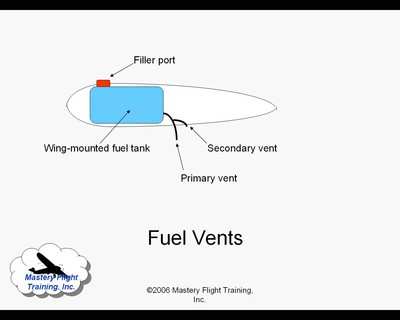Aero-Tips!
A good pilot is always learning -- how many times have you heard
this old standard throughout your flying career? There is no truer
statement in all of flying (well, with the possible exception of
"there are no old, bold pilots.")

Aero-News has called upon the expertise of Thomas P. Turner,
master CFI and all-around-good-guy, to bring our readers -- and us
-- daily tips to improve our skills as aviators. Some of them, you
may have heard before... but for each of us, there will also be
something we might never have considered before, or something that
didn't "stick" the way it should have the first time we memorized
it for the practical test.
Look for our daily Aero-Tips segments, coming each day to you
through the Aero-News Network.
Aero-Tips 11.14.06
Fuel Vents... UNOBSTRUCTED. It's a common step on an airplane's
Preflight Inspection checklist. But what are you really looking
for? Why is it so important to check fuel vents for
obstruction?
Tank types
There are three main types of fuel tank commonly installed in
general aviation airplanes (note: some airplane models may have
more than one type of tank installed):
- Bladder-type tanks-flexible rubber tanks, like big, thick
"balloons" in the wings or fuselage.
- Metal or fiberglass tanks-sealed containers for fuel set into
the wings or fuselage.
- "Wet wings" -- portions of the wing structure themselves that
are sealed to contain fuel and prevent leakage.
Fuel vents
Just like a portable gas tank for a lawn mower or boat, your
airplane's fuel tank requires a "push" of air pressure to keep fuel
flowing toward the engine. A blocked fuel vent can cause a vapor
lock that cuts off fuel flow -- causing a fuel starvation engine
failure even when there's a lot of fuel remaining in the tank.

Fuel vents come in many designs and location, but usually
consist of a stick, or probe, extending below the wing or fuselage.
Orientation of the vent is critical -- if it is not properly
slanted into the slipstream it may actually create suction from the
tank, instead of pressure into it.
Each individual fuel tank may have its own vent, or several
tanks may plumb into a single vent line. Secondary vents may be
recessed in the wing, or consist of a simple hole drilled in the
aft side of the primary vent. Secondary vents are your back-up in
case bugs, dirt or ice block the primary.
Fuel tanks have another reason for proper venting. If a vent
becomes obstructed the suction created by a fuel pump (or even a
carbureted engine) can be so great that the tank collapses.
Bladder tanks may bunch up so fuel can't get from parts of the tank
into the engine; hard tanks can dimple and bend; and wet wings may
collapse to the point the airfoil shape is disrupted and
aerodynamics severely compromised.

A metal "tip tank" that collapsed in
flight under the suction of fuel draw, after its vent line was
obstructed by an insect. (photo courtesy American Bonanza
Society)
Few Pilots Operating Handbooks tell precisely where fuel tank
vents are located, how they need to be oriented, whether they have
secondary holes that must also be open, or even how many fuel vents
there are on the airplane. Your best bet is to contact a user group
("type club") for your
particular airplane type for the proper tank vent inspection
requirements.
Aero-tip of the day: Check fuel vents for orientation and lack
of obstruction during every preflight check.
 ANN's Daily Aero-Linx (04.16.24)
ANN's Daily Aero-Linx (04.16.24) Aero-News: Quote of the Day (04.16.24)
Aero-News: Quote of the Day (04.16.24) Airborne 04.10.24: SnF24!, A50 Heritage Reveal, HeliCycle!, Montaer MC-01
Airborne 04.10.24: SnF24!, A50 Heritage Reveal, HeliCycle!, Montaer MC-01 Airborne 04.12.24: SnF24!, G100UL Is Here, Holy Micro, Plane Tags
Airborne 04.12.24: SnF24!, G100UL Is Here, Holy Micro, Plane Tags Airborne-Flight Training 04.17.24: Feds Need Controllers, Spirit Delay, Redbird
Airborne-Flight Training 04.17.24: Feds Need Controllers, Spirit Delay, Redbird





